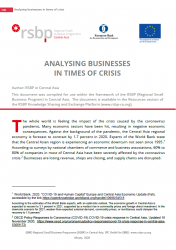The whole world is feeling the impact of the crisis caused by the coronavirus pandemic. Many economic sectors have been hit, resulting in negative economic consequences. Against the background of the pandemic, the Central Asia regional economy is forecast to contract by 1.7 percent in 2020. Experts of the World Bank state that the Central Asian region is experiencing an economic downturn not seen since 1995.[1] According to surveys by national chambers of commerce and business associations, 60% to 80% of companies in most of Central Asia have been severely affected by the coronavirus crisis.[2] Businesses are losing revenue, shops are closing, and supply chains are disrupted.

The crisis is undermining the income and liquidity levels of individuals and legal entities, including micro, small and medium-sized enterprises (MSMEs), as well as their ability to meet obligations to financial (credit) institutions. At the same time, everyone understands that without financial support, businesses will not be able to recover to pre-crisis levels for a long time. But, how can we, under such conditions, build relationships with clients, what and how should we evaluate their situation and outlook, and how can we make lending decisions and/or decisions on changing current loan payments, so that clients can survive the crisis and repay their loans in a way acceptable to financial institutions? In this article, we will give recommendations on what to look for when analyzing businesses during times of crisis.
In general business assessment is aimed at identifying potential trends and negative consequences for business development. At the same time, a high-quality assessment of the financial condition of a business gains more relevance during times of crisis, i.e. in unstable environments. We should keep our finger on the pulse of those enterprises that have already received a loan and now have to service their debt. We should also be able to analyse the businesses of new clients and assess their lending capacity in order to support them and the economy as a whole in overcoming the crisis.
Nowadays, many enterprises and sole proprietors find themselves in a difficult financial situation (temporary insolvency or even bankruptcy), and the task of an analyst is to determine the best support measures for a given client in the current situation. Such support measures could include changing the terms of an outstanding loan or, perhaps, providing additional finance.
During a crisis, business analysis involves objective assessment of a business’ financial condition, plans and development prospects, including its ability to adapt to the current and expected economic situation and trends.
In the process of decision-making about the possibility of cooperation with potential clients and/or support of existing clients, financial institutions take an integrated approach to the analysis (including analysis of market data and macroeconomic indicators, of formal and managerial financial statements, as well as retrospective and prospective business analysis). It is very important to look not only at numbers, but also to understand business processes and the (owner’s, management’s) current and future response to the crisis.
Shops may see declines in sales, manufacturers my see a drop in production output and sales, or the entire production process may come to a standstill because of a lockdown. There is an overall slowdown in profit-making business activities. At the same time, most business costs remain on the same level, and the financial balance in a business is disrupted, which translates into a decrease in financial stability of the business.
In a crisis, some people are prone to panic and to make irrational choices, other people “freeze in denial”, refuse to admit that the situation has changed and continue to live and work as if nothing has happened in the hope that things will resolve themselves on their own. Others, will analyze the situation and look at their business and circumstances as an opportunity for survival, think about possible measures to make the most of the changing environment. They may try to cut costs, find new sources of liquidity and income (for example, switch to a different, more reliable line of business and some may already have a contingency plan in place).
Here are some negative implications for a business that an analyst can observe in the process of analysis:
- decreasing revenues
- decreasing margins of individual business units (sales points, divisions)
- decreasing profits (or even losses)
- reduced liquidity (or lack of liquidity)
- delays in supplies and/or changes in supply chains
- disruption of supply chains
- termination of relations with suppliers
- an increase in accounts payable (to suppliers and creditors). Incurring private debts during such periods can be especially worrisome
- an increase in accounts receivable (customers stop paying on time)
- a decrease in working capital
- lack of finance
- loss of clients
- cancellation (failure) of contract obligations
- etc.
This list is not exhaustive. These negative consequences can even lead to business closure. However, let us look at the problem from a different perspective. In times of crisis, businesses need to be especially flexible, try to adapt to the new conditions, choose the right strategy that could help the business to overcome the crisis. For example, this could mean:
- reducing investment projects
- closing unprofitable production / points of sale
- selling non-core assets
- optimizing costs (especially, fixed costs such as rent, salaries, advertising, transport and other expenses)
- revising the assortment of goods
- entering new markets
- switching to online modes of conducting business
- changing settlement schemes with suppliers and buyers (reduction of payments, barter, etc.)
- making use of all available government support measures and tax opportunities to optimize spending
- etc.
The above-mentioned crisis phenomena and measures to overcome them serve as a hint for financial organizations on what to pay attention to in the process of risk analysis and assessment. However, attention should be focused not so much on the problems as such but on their depth and the tactical and strategic measures taken by the business (owners) to overcome the situation.
In order to find a way out of the crisis, business owners and their teams (depending on the size of the business) explore opportunities, analyse their own business, the market and general economic trends, and they take action. Our task, as analysts, is to recognize measures that are focused on overcoming the impacts of the crisis, to evaluate them and draw conclusions. If a company is "in panic" and does not take any measures, then we must clearly understand that financing it is associated with a high risk. If a business takes active and meaningful actions as a reaction to the current circumstances, looks out for options to adapt to the situation and has a real perspective for the future, then financing such a business is associated with fewer and lower risks. Thus, apart from current financial indicators, the first thing to pay attention to during the analysis is the owners’ (management’s) own reaction, how they assess the situation, how they plan to get out of it, and how this will affect their business productivity and financial performance. A business can still be profitable and have good credit capacity at this time, but the owners’ (management’s) actions/ omissions can lead to a situation where the business may become unable to pay in a matter of weeks or months. Therefore, it is important to see how effective and rational the owners’ plan is, and whether it is focused on business growth and development, even in a difficult period.
What business periods should financial institutions consider and what should they focus on in their analysis?
Analysing past periods. What is the point of this? The purpose of analysing business development over periods preceding the crisis is to understand how much the situation has changed and evaluate the steps taken by the owners. If a business shows a dramatic decline in revenues, profits, has liquidity gaps and/or other negative trends, the probability is high that owners so far have not taken any action or only insufficient action. In this case, it is high-risk for a financial institution to finance/work with such a business, since the owners (management) are likely to continue with their wait-and-see attitude in the hope that the situation will resolve itself on its own.
If you analyse a business that has already survived economic crises in the past, you should look at how they managed this. It is not necessary to delve into accounting records, but sufficient to talk with the owners (management) and find out whether they had to reduce or optimize their business or not, how they got out of the situation back then, and compare this with the current circumstances.
Analysis of the current situation. Get answers to the following questions:
- Can the business cope with the current debt burden? How long will it be able to serve its current debts? From where does the business get the necessary resources? Why is it asking for more finance?
- To what extent is the client now dependent on borrowings?
- Given the current state of affairs, will the client be able to cope with an additional debt burden?
If a business needs a loan only to stay afloat, and you see that it is “frozen in a waiting loop” and/or there are signs of possible negative future trends, then financing such a business will bear high risks. You should always make sure that additional financing will not further aggravate the situation of the business.

Under conditions of uncertainty, the analysis of business prospects should be focused on the current situation and on the client's plans to overcome the crisis. The analysis involves an assessment of the client's plans against the background of general economic trends in the client's market and the economy as a whole, as well as the assessment of the relevance of the client’s plans against these trends (including the likelihood of meeting planned sales targets, income and expenses). If, in the process of your analysis, you see that the client has reconfigured business processes, abandoned ineffective projects, focused on products that are relevant and in demand in the current situation, and has a vision for future business development (at least, for some time horizon), skilfully manages his/her debtors (at least, works with them), tries to maintain acceptable liquidity and own working capital levels, then working with such a client will be less risky.
Therefore, when analysing a business in times of crisis, it is important to assess the business’ tactical, short-term measures, as well as its strategy to keep the situation under control and overcome the crisis. It is also necessary to analyse the core financial indicators (current and expected) which we use to assess business performance under normal conditions. These indicators include:
- balance sheet indicators such as equity, receivables and payables, working capital structure
- trends in the revenue structure, profitability and profit
- business liquidity and safety margin.
Analyse the firm's financial statements and collect managerial accounting data.
Look at the sources of financing that the business uses (owner’s equity, long-term or short-term loans). Having studied the structure of liabilities, you will be able to understand possible causes of financial instability of the business. This could be a high share of debts in the balance sheet total (more than half), which could mean that the business is highly dependent on its creditors.
Pay attention to the speed of growth of accounts receivable and payable, as well as their ratios. Their growth rates should be approximately the same.
Examine financial statements for any losses in the analysed period. You could notice changes in mark-ups, past due loans, receivables and payables.
Assess the liquidity and profitability levels of the business in the short and medium term. In a crisis, it is quite difficult to carry out medium-term cash flow projection and assessment of profit levels. Nevertheless, you can forecast cash flow and profit for the coming months, as well as build positive and negative scenarios (in case of stabilization and/or worsening of the situation). In any case, during situations of crisis and uncertainty, loan officers of financial institutions must conduct regular monitoring of their clients (the frequency of such monitoring is usually higher than in a stable environment). The purpose of monitoring is to check and assess the accuracy of cash flow and profitability forecasts. Monitoring allows loans officers to respond to any changes in the situation in a timely manner and adjust financial forecasts, payment plans and other credit conditions as necessary.
In the current conditions, financial institutions should adjust their conclusions and assessments to the crisis. If you see that a business is flexible and ready to not only manoeuvre with financial resources, but can also skilfully adapt its business processes and schemes, and optimize its activities, thus ensuring financial stability, then you can analyse such a business, evaluate data and take informed decisions with acceptable risk for the financial institution. You may not necessarily encounter super-profits in the process of analysis, but you can evaluate the scale of the changes and measures taken by the business to overcome the crisis and period of uncertainty, and assess the prospects of this business for the future. And this is the basis for finding the best way to support clients in crisis and post-crisis conditions.
[1] World Bank. 2020. “COVID-19 and Human Capital” Europe and Central Asia Economic Update (Fall), accessible by the link https://openknowledge.worldbank.org/handle/10986/34518
According to the estimates of the World Bank experts, with an optimistic outlook, “the economic growth in Central Asia is expected to recover to 3.1 percent in 2021, supported by a modest rise in commodity prices and foreign direct investment. In the downside scenario for 2021, weaker-than-expected external demand, commodity prices, or remittances could dampen the recovery to 1.5 percent.”
[2] OECD Policy Responses to Coronavirus (COVID-19).COVID-19 crisis response in Central Asia, Updated 16 November 2020, https://www.oecd.org/coronavirus/policy-responses/covid-19-crisis-response-in-central-asia-5305f172/
Pictures designed by Freepik



